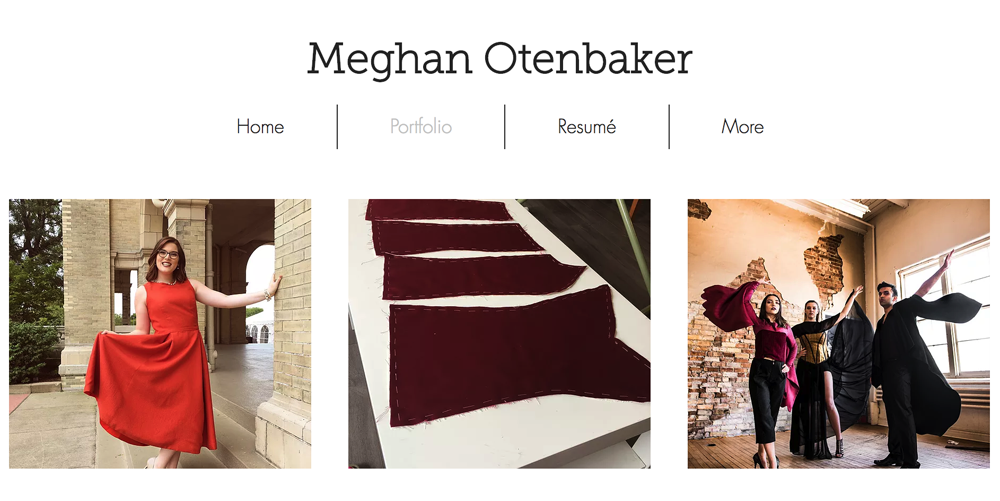Written by Eric (he/him), student
If you're studying visual or performing arts, one of the most important things you can do as a student looking for a part-time or summer job (and eventually a co-op or internship program) is to build a portfolio.
A portfolio can benefit you both during school (by ensuring you keep a detailed list of all your experiences, with examples) and after graduation (to help you land jobs and market yourself to the world).
But you’re probably wondering how to start building a portfolio. Fortunately, there are many things you can do to get started now.
- Use your strongest pieces
- You don’t need to include everything you’ve ever worked on. Focus on adding the strongest projects and show off your best work.
- Showcase a variety of work
- Include different types of work to show off your versatility and your wide range of abilities. For example, an artist could show a drawing, a painting, and maybe even digital design.
- Don't make it too long!
- Stay between 10 to 20 pieces when creating your portfolio to make sure you capture your audience but don’t overwhelm them.
- On and offline
- Create both a physical and online version of your portfolio so you can be versatile. It might be nice to have something physical you can bring to an in-person interview, but it’s also important to have something permanent and easily referenced online or linked to on your résumé.
- Get someone to review it
- It’s never a bad idea to have someone to look at your portfolio. Asking your parents, a teacher, or even a friend to look at your portfolio can be a good way to fix any issues and add anything that might be important.
Keep high school assignments
A lot of people don’t think twice before recycling all their assignments when they finish a class in high school. However, those assignments can actually be very useful when creating your portfolio. By keeping old assignments, you’re holding on to examples of your ability to excel on both an academic and personal level.
For example, the essays you write in high school can be valuable in demonstrating your ability to articulate your thoughts into words and form a cohesive argument. Other projects you may want to include are presentations, business cases and their financials, copywriting samples, short stories, etc.
“Look at what employers are asking you for and cater your work/words to how you describe your abilities. Show that you’re capable of what they require.

Show your work online!
Create an online portfolio
It may seem intimidating to create your own online portfolio, but online portfolios are actually a really easy and helpful way to organize your work and experience. Websites like Wix.com and WatCV are designed to help you layout your portfolio in a nice and appealing way. These websites allow you to add pictures, videos, projects, assignments, and anything else that you think would spice up your portfolio and give it that extra “oomph!”. Plus, many of these services are free!
Build a blog or vlog
Creating a blog is something else that can be really helpful, too. The best thing about using a blog is the ability to be as creative as you want – you can present yourself in a way that best suits who you are. You can even use video, which would make it a vlog, of course. But whether it’s a blog or a vlog, it’s your space to share something you’re passionate about.
Acting is my thing, so I could do a blog/vlog about movie reviews. Although I’d be doing it for fun, I could share it with an employer; and it would be a great opportunity to showcase my writing skills, my ability to think critically and show my thought processes, and it would demonstrate my dedication to the things that matter to me.
Similarly, if you’re more of a visual artist, you could create an Instagram account to showcase the work you’ve created. Adding a link to any of these extra pieces in your portfolio can be very helpful, especially if you’ve received a lot of feedback on your work.

This website site belongs to Meghan, a third-year Theatre and Performance student who is also in co-op. Meghan has created this website to help show off her awesome design skills!
Tips for creators
Hang on to visuals that show your experience
In drama, dance, music, and fine arts specifically, keeping projects you’ve worked on or pieces you’ve created can make the perfect additions to your portfolio and will definitely help beef it up. If you’re in a co-op or internship program, you can bring these pieces to job interviews (e.g., photography samples; photos of your paintings, sculptures, prints or the real thing; sketches; or video or audio recordings).
For me, I’ve included a lot of my experiences in my portfolio to show off the different skills I’ve developed — from the smallest task of setting up a bulletin board for a high school event to taking pictures at my cousin’s wedding.
Having photos and videos of your work is an amazing way to showcase your skills and is sometimes a better way to articulate your talent than words on paper.
When I submitted my university application, I added a copy of my résumé, and although it wasn’t necessarily a portfolio, it still included a lot of the experiences and jobs that I’d had. If I’d known more about portfolios at the time I was applying, I definitely would’ve included that as well.
Tips for actors
This point is geared more towards those pursuing a career in performance art, but a big part of your portfolio as a performer will be listing your prior participation in shows. Whether it’s as an actor, director, stage manager, or stage crew, it’s important to include everything, as people in the performing arts world will look at all of your experiences both on and off stage.
I’m currently a third-year Theatre and Performance student at Waterloo and I’ve been keeping track of all my performances for years, allowing me to create a robust acting portfolio.
Overall, when building your portfolio, it’s important to remember and think about what you want other people to know about you and what skills you want to highlight. Really any experience is valuable and the more you add to your portfolio, the more heads you’ll turn. It’s also important to remember to get lots of experience in a number of different areas.
Even though you may be focusing on a studio art degree, having experience in performing arts or film is a great way to increase your marketability and make you more flexible and qualified when looking for a job.
A portfolio can be your best friend when you’re looking to get involved or interviewing for part-time or summer jobs, so having one in your back pocket is always good idea.
Using these tips will hopefully get you on the right track when creating your portfolio. And always remember to be yourself and show off those awesome skills you have!
Related articles

How high school co-op can kickstart your career
Have you taken advantage of your high school's co-op program? Discover how it can work for you!

Why and how to use LinkedIn in high school
If you’re 16 or older, the pearly gates of this networking heaven are wide open and it may just help you achieve your university and career goals. Why should you use it? How should you use it? We’re glad you asked.

Building a résumé before university
Putting time and effort into creating a great résumé while you’re still in high school might seem pointless, but it’s actually a great way to get ahead of the game.

